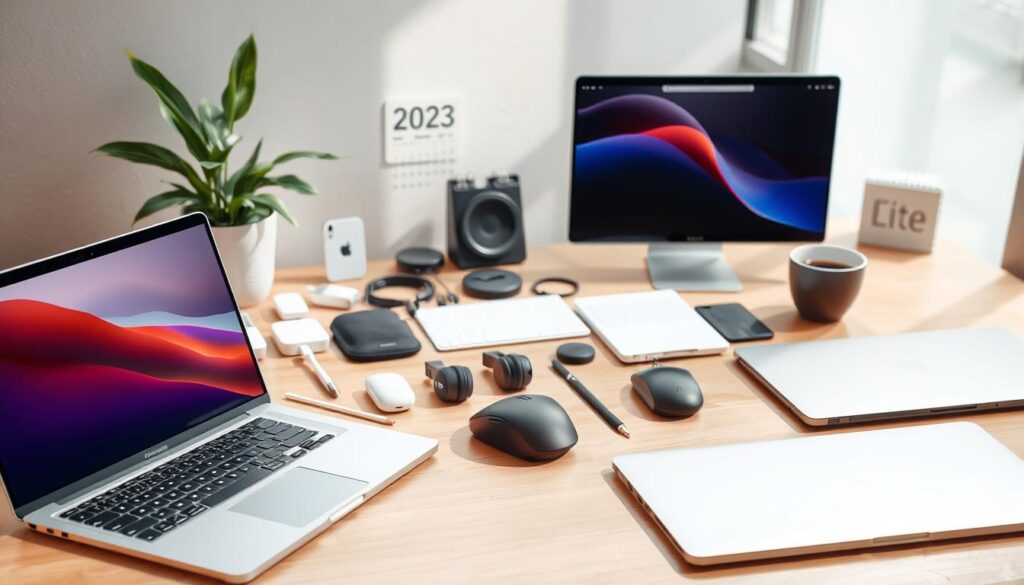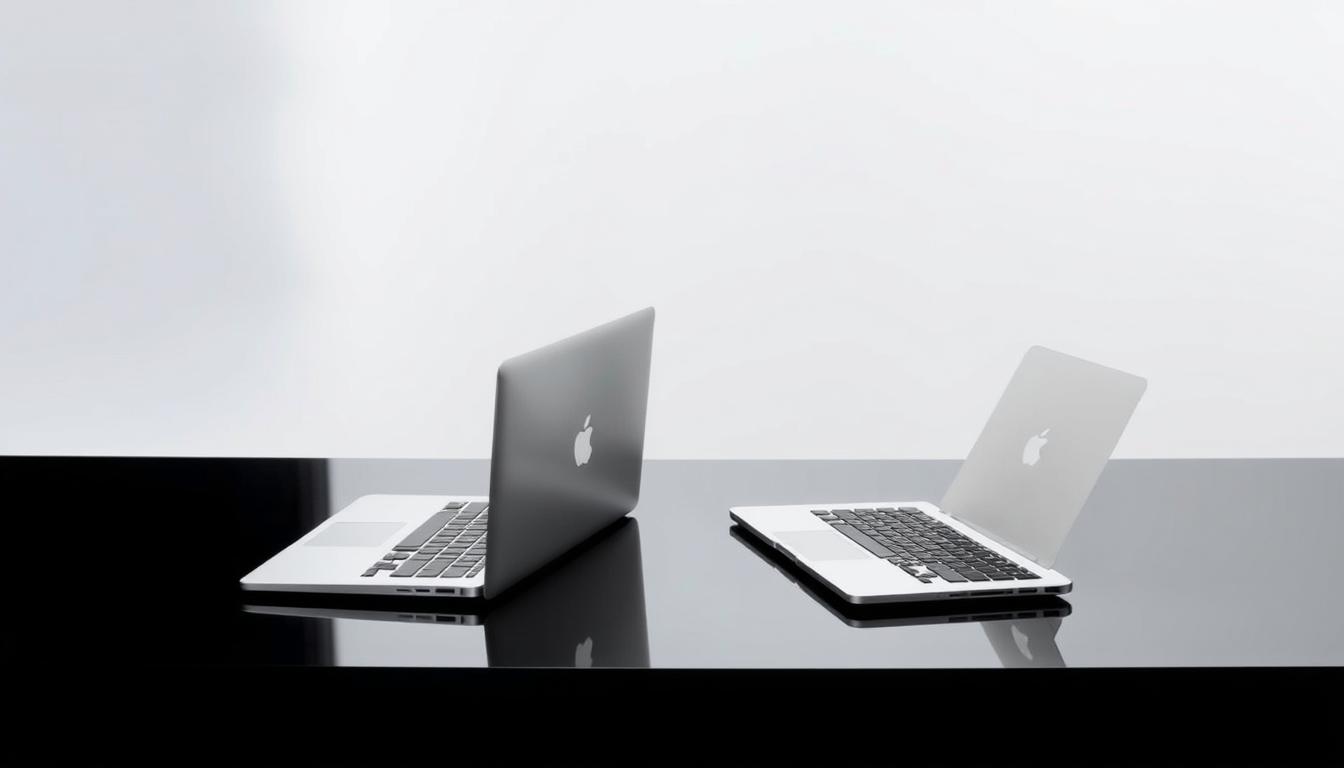When choosing between the MacBook Air and MacBook Pro, which one fits your needs better? Apple’s latest models range from 13-inch portability to 16-inch power. The MacBook Air starts at $999 with an M3 chip, while the Pro starts at $1,599 and has up to a 32-core GPU. But how do their specs match up with what you need?
Deciding between these laptops involves looking at details like battery life and performance. The Air lasts 15 hours, while the Pro’s 3.5x faster M4 Max GPU is a big plus. This guide covers everything, from the M4 Pro’s 14-core CPU to the Air’s 2.7-pound weight. It helps you find the best value, avoiding spending too much or too little.
Key Takeaways
- The MacBook Pro’s M4 Max chip offers 3.5x faster performance than the M1, while the Air’s M3 provides 35% faster CPU than earlier models.
- Prices range from $999 for the Air to $4,000 for high-end Pro models, reflecting differences in chips like the M4 Pro’s 20-core GPU.
- Battery life varies: the Air streams video for 15 hours, while the Pro’s 16-inch model lasts 22 hours during web browsing.
- The Air’s 15-inch model weighs 3.3 lbs, while the Pro’s 16-inch version hits 4.7 lbs, impacting portability.
- RAM starts at 16GB across both lines, but Pro models can upgrade to 48GB for heavy multitasking.
Understanding the MacBook Lineup in 2025
Choosing a MacBook means looking at a buying guide that shows similarities and in-depth analysis of features. Apple’s 2023 lineup has devices for every need, from the sleek MacBook Air to the high-end Pro models. The recent $100 price drop for the M4 MacBook Air and better chip performance make now a great time to look.

Evolution of the MacBook Air
The MacBook Air was first shown by Steve Jobs in 2008, setting a new standard for thinness. Today’s M3 models, like the 15-inch Air, weigh just 3.3 pounds and last up to 19 hours. The $999 starting price is $200 less than Pro models, but it shares features like Retina displays and macOS integration.
- 2023 M3 Air: 15-inch screen, 500 nits brightness
- M3 Max Pro: Up to 128GB RAM, 8TB storage options
Apple Silicon Revolution: M1 to M3
Apple’s switch from Intel to their own chips brought huge improvements. The M3 Max has 12 performance cores and 400GB/s bandwidth, beating older models. Here’s a comparison of chip generations:
| Chip | Cores | RAM Options | Bandwidth |
|---|---|---|---|
| M3 | 4+4 | Up to 64GB | 400GB/s (Max variant) |
| M3 Pro | 12 total | Up to 96GB | 300GB/s |
Geekbench scores show the M3 Max’s multi-core performance is 67% better than the M2 Max. This in-depth analysis explains why Pro models cost more.
Knowing these advancements helps buyers find the right MacBook for their needs. Whether you need something portable or powerful, Apple has you covered.
Design and Build Quality Comparison
When we look at the MacBook Air and MacBook Pro, we see different design focuses. Both have aluminum unibody construction. But the Air got a 2022 update to lose its tapered edges, making it look like the Pro. The Air is 2.7 lbs, 0.7 lbs lighter than the 14-inch Pro, making it great for carrying around.

- Color Options: Air offers four hues (Midnight, Starlight, Sky Blue, Silver) vs. Pro’s two (Silver, Space Black)
- Thickness: Air’s 0.44-inch chassis vs. Pro’s 0.61-inch depth
- Display Size: 13.6-inch Air vs. 14-inch Pro, with Pro’s larger screen retaining fan-based cooling
The Air is quiet because it doesn’t have a fan. But it can’t handle heavy tasks for long. The Pro, with its fan, can handle more work. Both have Liquid Retina XDR displays, but the Pro’s screen is brighter, at 1,000-nit, compared to the Air’s 500-nit.
Choosing between the Air and Pro depends on how you use your laptop. The Air is perfect for daily use because of its light weight and colors. The Pro is better for those who need more power, like creatives. The 2025 updates kept these differences in mind, with the Air’s 15-inch model getting closer but not quite matching the Pro’s cooling.
Performance Breakdown: MacBook Air vs MacBook Pro
To see how the MacBook Air and Pro do in real tasks, we need to look closely at their specs and how they handle heat. The Pro’s M4 Pro chip beats the Air’s M4 in tasks that need lots of cores. This means the 16-inch Pro is faster at video editing and coding.
The Air doesn’t have a fan, so it can’t keep up with heavy tasks for long. This limits its performance when it’s really needed.
Processor Benchmarks and Real-World Performance
Geekbench 6 tests show the 16-inch Pro’s M4 Pro chip is way ahead of the 14-inch Pro. It has 14 CPU cores, while the 14-inch has 10. This means faster work in Xcode and smoother multitasking for you.
The Air’s 8-core GPU is good for light tasks but can’t keep up with the Pro’s 40-core GPU options in 3D modeling.
RAM and Storage Options
- Air: 16–32GB RAM, 256GB–2TB storage
- Pro: 24–128GB RAM, 512GB–8TB storage
The Pro has more RAM, which helps with photo editing. The Air’s limits might slow down big projects.
Thermal Management
The Air stops working well after a while because it doesn’t have a fan. The Pro keeps going strong for 8+ hours of video editing. This makes it a better choice for professionals.
Display Technology and Visual Experience
When choosing between MacBook models, the display is key. The MacBook Pro’s Liquid Retina XDR screen shines with 1,600 nits HDR brightness. This is twice as bright as the Air’s 500 nits. It offers deeper blacks and brighter highlights.
The Air has a 15.3-inch screen, but the Pro’s 14.2-inch display is better for contrast and color. This makes a big difference in how you see your work.
- Brightness: Pro’s 1,600 nits HDR vs Air’s 500 nits
- Refresh Rate: 120Hz ProMotion (Pro) vs 60Hz (Air)
- Color: Pro’s 1.07 billion colors vs Air’s 1.06 billion
The Pro’s 120Hz adaptive refresh rate makes scrolling and gaming smoother. It’s perfect for photo editing, with a Delta-E of 0.19. The Air’s Delta-E is 0.22.
The Pro’s XDR tech gives better contrast ratios for HDR content. It also has a higher resolution, 3,024×1,964, than the Air’s 2,880×1,864. This is great for detailed work.
For everyday tasks, the Air’s 60Hz is enough. But if you edit 4K videos or work outdoors, the Pro’s displays are better. The Air’s larger screen is cheaper but lacks peak brightness and refresh rate.
Battery Life, Portability, and Everyday Usability
When choosing between the MacBook Air and Pro, it’s important to consider their practical features. Let’s look at how battery life, size, and connectivity affect daily use.
Battery Performance Under Different Workloads
The MacBook Air can last up to 18 hours for watching videos. On the other hand, the MacBook Pro 14-inch can go up to 24 hours for the same task. The Pro has a bigger battery, which helps it handle demanding tasks better.
In tasks like video editing, the Pro stays efficient thanks to its cooling system. The Air might slow down when doing intense tasks for a long time.
Weight and Form Factor Considerations
- The MacBook Air (15-inch) weighs 3.3 lbs, making it lighter than the 14-inch Pro (3.4 lbs). This makes it easier to carry around.
- The Pro models are a bit heavier but have cooling systems that help during multitasking.
Port Selection and Connectivity
Port differences are key. The Air has two Thunderbolt 4/USB-C ports. The Pro, on the other hand, has HDMI, SDXC, and an extra Thunderbolt port. This makes the Pro better for those who need to connect to external devices or 4K monitors without using dongles.
The Air’s design is simpler, perfect for those who value ease of use. For which is better, think about your needs. The Air is great for students or travelers, while the Pro is better for professionals. It’s about finding the right balance between portability and power for your daily routine.
Price-to-Performance Analysis and Value Proposition
When deciding between the macbook air vs macbook pro, it’s important to consider both cost and value. The MacBook Air starts at $999 and offers 18 hours of battery life. It also has up to 2TB storage. On the other hand, the MacBook Pro 14-inch starts at $1,599 and includes more ports, active cooling, and up to 8TB storage.
For basic tasks like browsing the web or checking email, the Air is a great choice. It lasts 15+ hours on a single charge. But, if you need more power for work, the Pro is worth the extra $600. It offers 24-hour battery life and 128GB RAM for heavy multitasking.
Looking at performance, the Air’s M3 chip scores 3,082 in single-core benchmarks. The Pro’s M3 Pro scores 3,100. But, in tasks like video rendering, the Pro’s 128GB RAM and 4.4GHz CPU are better. For gamers, the Pro’s 119 FPS in Tomb Raider beats the Air’s 25 FPS, showing its strength in demanding tasks.
- Value sweet spot: The $1,299 MacBook Air 15-inch with 512GB storage is 20% faster than the base Air for $300 more.
- Hidden costs: The Air has only one Thunderbolt port, while the Pro has two. This might mean buying dongles for using multiple devices.
- Resale advantage: The Pro keeps 65% of its value after two years, compared to the Air’s 55%, according to 2023 data.
For most users, the Air’s $999 base model is a great value for everyday tasks. But, if you need more power for complex tasks or using two external displays, the Pro’s features are worth the extra cost. Considering these points will help you choose the right one in the macbook air vs macbook pro comparison.
MacBook Air vs MacBook Pro: Which Model Suits Your Specific Needs?
Choosing between the MacBook Air and Pro depends on your daily tasks. This buying guide makes the comparison easy. It helps you find the right device for your needs.
Students and Casual Users
Students or those who use apps like Chrome and Zoom will love the MacBook Air. It has a 13.6-inch screen and an M2 chip. It lasts up to 18 hours and weighs only 2.7 pounds.
Choose at least 8GB RAM and 256GB storage for a balance of portability and functionality. The Air is perfect for classrooms or cafes because of its sleek design and quiet operation.
Content Creators and Designers
Editing 4K videos or using Adobe Suite? The 14-inch or 16-inch MacBook Pro with an M3 Pro chip is your best bet. It has a 32-core GPU and up to 64GB RAM for smooth multitasking.
Photographers will appreciate the Pro’s six-speaker system and color-accurate displays. Hobbyists can start with the 13-inch Pro, but professionals need the 16-inch model for 8TB storage.
Developers and Technical Users
Need to compile code or run virtual machines? The 16-inch Pro is ideal with its 10-core CPU and 32-core GPU. Developers will appreciate the Pro’s expanded RAM (up to 64GB) and Thunderbolt ports for external GPUs.
The Air can’t compare here because of its lack of fans. The Pro’s cooling ensures it performs well during long coding sessions.
Business and Travel
Business users might prefer the Air for its lightness, but Pro models have HDMI ports and SD card slots for presentations. The Air is quiet and has all-day battery for remote teams.
Executives doing 3D modeling need the Pro’s power. Both models have Apple’s security features, but the Pro’s MagSafe charger is more durable for travel.
Not sure? The choice between Air and Pro depends on your workflow. The Air is great for beginners, while the Pro is for specialized tasks. Let Apple’s specs match your daily needs.
Conclusion: Making Your Final Decision
Choosing between the MacBook Air and MacBook Pro depends on what you need. The MacBook Air is great for everyday tasks like browsing and emails. It has a 13.6-inch Liquid Retina display and lasts up to 18 hours on battery.
It’s also very light, weighing just 2.8 pounds. This makes it easy to carry around in your backpack or briefcase.
If you need more advanced features, the MacBook Pro is the better choice. It has a longer battery life (up to 20 hours) and powerful processors. These are perfect for tasks like video editing and coding.
But, the MacBook Pro is pricier and heavier (3.0–4.7 pounds). Think about your budget and what you do every day. The Air is cheaper, but the Pro offers more for those who need it.
Consider if you need to multitask or if a budget-friendly option is enough. Most buyers look at price first. The Air is often a better value for basic tasks.
Check out deals if you’re unsure. The Air sometimes goes for under $1,000. The Pro offers more storage (up to 8TB SSD) and better audio for creatives.
Ultimately, the right choice depends on your needs. It’s about finding the right balance between performance, portability, and your workflow.





Thankx for your information I ‘m student and now due to your artucle i ‘ll choose Macbook Air, Keep posting such blogs.. next topic should be related to technology